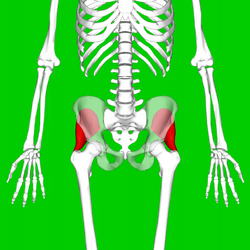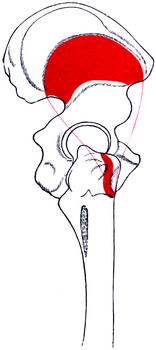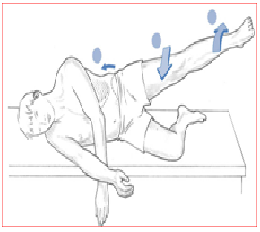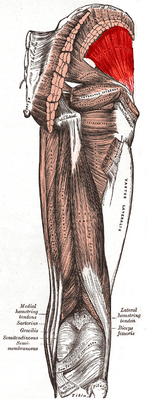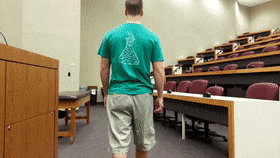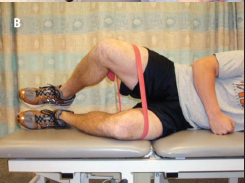Gluteus Minimus: Difference between revisions
No edit summary |
Candace Goh (talk | contribs) mNo edit summary |
||
| (44 intermediate revisions by 9 users not shown) | |||
| Line 1: | Line 1: | ||
'''Original Editor '''- [[User:George Prudden|George Prudden]], | '''Original Editor '''- [[User:George Prudden|George Prudden]], | ||
'''Top Contributors''' - {{Special:Contributors/{{FULLPAGENAME}}}}; | '''Top Contributors''' - {{Special:Contributors/{{FULLPAGENAME}}}}; | ||
== Introduction == | |||
[[File:Gluteus minimus muscle08.png|alt=|thumb|250x250px|Gluteus minimus muscle.]] | |||
Gluteus minimus [[muscle]] is the smallest one of the three [[Gluteal Muscles|gluteal muscles]], it lies deep to the [[Gluteus Medius|gluteus medius]] muscle. The gluteus minimus is similar to the gluteus medius in function, structure, [[Neurone|nerve]] and [[blood]] supply.<ref name=":0">Greco AJ, Vilella RC. [https://www.ncbi.nlm.nih.gov/books/NBK556144/ Anatomy, Bony Pelvis and Lower Limb, Gluteus Minimus Muscle.] InStatPearls [Internet] 2020 Apr 11. StatPearls Publishing.</ref> | |||
The gluteus minimus | The gluteus minimus acts in synergy with the gluteus medius to abduct and internally rotate the thigh, and contributes to the stabilisation of the [[Hip Anatomy|hip]] and [[pelvis]]<ref>Ken hub [https://www.kenhub.com/en/library/anatomy/gluteal-muscles Gluteal muscles] Available: https://www.kenhub.com/en/library/anatomy/gluteal-muscles (accessed 12.1.2022)</ref>.[[File:Gluteus minimus attachments.png|350x350px|alt=|thumb|Gluteus minimus of right side: outline and attachment-areas.]] | ||
= | === Origin === | ||
External surface of the [[ilium]], between the anterior and inferior gluteal lines.<ref name=":1">Standring S, Ellis H, Healy J, Johnson D, Williams A, Collins P, Wigley C. Gray's anatomy: the anatomical basis of clinical practice. American Journal of Neuroradiology. 2005 Nov;26(10):2703.</ref> | |||
=== Insertion === | |||
Gluteus minimus muscle is fan-shaped, it inserts at the anterolateral aspect of the greater trochanter of the [[femur]].<ref name=":1" /> | |||
=== N'''erve Supply'''=== | |||
Superior gluteal nerve ('''L4''', '''L5''', '''S1''')<ref name=":0" /><ref name=":1" /> | |||
== | == Blood Supply == | ||
It is supplied by deep branch from superior gluteal artery<ref name=":0" /><ref name=":1" />[[File:Hip Abduction Test.png|alt=|right|frameless]] | |||
== Action == | |||
Its main action is '''hip abduction'''. | |||
# It stabilises the pelvic during single limb support in the [[gait]], as it is activated on the supported side, to keep the pelvic from dropping on the opposite swing side. | |||
# Its anterior segment medially rotates the thigh.<ref name=":0" /> | |||
[[File:Gluteus minimus muscle.png|right|frameless|400x400px]] | |||
== Clinical relevance == | |||
* Weakness in the gluteus minimus results in [[Trendelenburg Gait|trendelenburg gait]], where the pelvic drops on the unsupported side. | |||
*[[Lateral Step Down Test|Lateral step down test]] is used to assess quality of movement around lower [[Kinetic Chain|kinetic chain]].<ref name=":2">Whiler L, Fong M, Kim S, Ly A, Qin Y, Yeung E, Mathur S. [https://www.ncbi.nlm.nih.gov/pmc/articles/PMC5963550/#B18 Gluteus medius and minimus muscle structure, strength, and function in healthy adults: brief report.] Physiotherapy Canada. 2017;69(3):212-6.</ref><ref name=":3">Piva SR, Fitzgerald K, Irrgang JJ, Jones S, Hando BR, Browder DA, Childs JD. [https://www.ncbi.nlm.nih.gov/pmc/articles/PMC1557500/ Reliability of measures of impairments associated with patellofemoral pain syndrome.] BMC musculoskeletal disorders. 2006 Dec 1;7(1):33.</ref> | |||
* Gluteus minimus tendinopathy often results in [[Greater Trochanteric Pain Syndrome]] (GTPS). | |||
* Gluteus minimus [[Trigger Points|trigger points]] : Gluteus Minimus is a multipennate muscle with multiple anterior, middle, and posterior trigger points referring strong pain in the [[Lumbar Anatomy|lumbar spine]] and ends at the [[Ankle and Foot|ankle]], following a similar pain pathway of [[Sciatic Nerve|sciatic nerve]] but without the neurological symptoms of the [[Sciatica|sciatic]] nerve such as weakness and numbness.<ref name=":0" /> The 4 minute video below is titled - Gluteus Minimus Pain and Trigger Points | |||
{{#ev:youtube|sJhNTsMi0-U|300}}<ref>TrPTherapist. Gluteus Minimus Pain and Trigger Points | |||
. Available from: http://www.youtube.com/watch?v=dMH0bHeiRNg [last accessed 18/12/2022]</ref> | |||
== Assessment == | |||
[[File:Trendelenburg Gait.gif|alt=|thumb|Trendelenburg Gait]][[Trendelenburg Sign|Trendelenburg sign]] is used to assess the strength of the hip abductors (gluteus medius and gluteus minimus). It is done by asking the patient to do single limb support on the tested leg, while observing the patient from behind to observe the pelvic alignment. If the pelvic drops or deviates from the midline it is indicative of hip abductors weakness.<ref name=":2" /> | |||
= | == Physical Therapy Management == | ||
[[File:Hip exercises 2.png|right|frameless]] | |||
The gluteus minimus is composed of two distinct segments (anterior and posterior) with two different roles. The anterior segment reduces the stresses on the hip anterosuperior structures and the posterior segment stabilises the head of the femur. Atrophy in the anterior segment is associated with increased risk of [[Falls in elderly|falls]], aging and [[Total Hip Replacement|total hip replacement]]. | |||
Recommended [[Strength Training|strengthening]] exercises include: | |||
* Exercises that strengthen anterior segment: resisted hip abduction-extension exercise. | |||
* Exercises that strengthen posterior segment: single leg bridge, side lie abduction, the resisted hip abduction-extension exercise and single leg squat. | |||
* Exercises that produced low activity in both segments: side lie clam. | |||
* Low activity was generated in the anterior segment in the single leg bridge.<ref>Moore D, Semciw AI, McClelland J, Wajswelner H, Pizzari T. Rehabilitation Exercises for the Gluteus Minimus Muscle Segments: An Electromyography Study. Journal of sport rehabilitation. 2019 Aug 1;28(6):544-51.</ref> | |||
== References == | |||
= | |||
<references /> | <references /> | ||
<br> | |||
[[Category:Hip]] [[Category: | [[Category:Anatomy]] | ||
[[Category:Muscles]] | |||
[[Category:Hip]] | |||
[[Category:Musculoskeletal/Orthopaedics]] | |||
[[Category:Hip - Anatomy]] | |||
[[Category:Hip - Muscles]] | |||
Latest revision as of 05:39, 30 January 2024
Original Editor - George Prudden,
Top Contributors - Lucinda hampton, George Prudden, Elvira Muhic, Kim Jackson, Lilian Ashraf, Khloud Shreif, WikiSysop, Candace Goh, Evan Thomas and Joao Costa;
Introduction[edit | edit source]
Gluteus minimus muscle is the smallest one of the three gluteal muscles, it lies deep to the gluteus medius muscle. The gluteus minimus is similar to the gluteus medius in function, structure, nerve and blood supply.[1]
The gluteus minimus acts in synergy with the gluteus medius to abduct and internally rotate the thigh, and contributes to the stabilisation of the hip and pelvis[2].
Origin[edit | edit source]
External surface of the ilium, between the anterior and inferior gluteal lines.[3]
Insertion[edit | edit source]
Gluteus minimus muscle is fan-shaped, it inserts at the anterolateral aspect of the greater trochanter of the femur.[3]
Nerve Supply[edit | edit source]
Superior gluteal nerve (L4, L5, S1)[1][3]
Blood Supply[edit | edit source]
It is supplied by deep branch from superior gluteal artery[1][3]
Action[edit | edit source]
Its main action is hip abduction.
- It stabilises the pelvic during single limb support in the gait, as it is activated on the supported side, to keep the pelvic from dropping on the opposite swing side.
- Its anterior segment medially rotates the thigh.[1]
Clinical relevance[edit | edit source]
- Weakness in the gluteus minimus results in trendelenburg gait, where the pelvic drops on the unsupported side.
- Lateral step down test is used to assess quality of movement around lower kinetic chain.[4][5]
- Gluteus minimus tendinopathy often results in Greater Trochanteric Pain Syndrome (GTPS).
- Gluteus minimus trigger points : Gluteus Minimus is a multipennate muscle with multiple anterior, middle, and posterior trigger points referring strong pain in the lumbar spine and ends at the ankle, following a similar pain pathway of sciatic nerve but without the neurological symptoms of the sciatic nerve such as weakness and numbness.[1] The 4 minute video below is titled - Gluteus Minimus Pain and Trigger Points
Assessment[edit | edit source]
Trendelenburg sign is used to assess the strength of the hip abductors (gluteus medius and gluteus minimus). It is done by asking the patient to do single limb support on the tested leg, while observing the patient from behind to observe the pelvic alignment. If the pelvic drops or deviates from the midline it is indicative of hip abductors weakness.[4]
Physical Therapy Management[edit | edit source]
The gluteus minimus is composed of two distinct segments (anterior and posterior) with two different roles. The anterior segment reduces the stresses on the hip anterosuperior structures and the posterior segment stabilises the head of the femur. Atrophy in the anterior segment is associated with increased risk of falls, aging and total hip replacement.
Recommended strengthening exercises include:
- Exercises that strengthen anterior segment: resisted hip abduction-extension exercise.
- Exercises that strengthen posterior segment: single leg bridge, side lie abduction, the resisted hip abduction-extension exercise and single leg squat.
- Exercises that produced low activity in both segments: side lie clam.
- Low activity was generated in the anterior segment in the single leg bridge.[7]
References[edit | edit source]
- ↑ 1.0 1.1 1.2 1.3 1.4 Greco AJ, Vilella RC. Anatomy, Bony Pelvis and Lower Limb, Gluteus Minimus Muscle. InStatPearls [Internet] 2020 Apr 11. StatPearls Publishing.
- ↑ Ken hub Gluteal muscles Available: https://www.kenhub.com/en/library/anatomy/gluteal-muscles (accessed 12.1.2022)
- ↑ 3.0 3.1 3.2 3.3 Standring S, Ellis H, Healy J, Johnson D, Williams A, Collins P, Wigley C. Gray's anatomy: the anatomical basis of clinical practice. American Journal of Neuroradiology. 2005 Nov;26(10):2703.
- ↑ 4.0 4.1 Whiler L, Fong M, Kim S, Ly A, Qin Y, Yeung E, Mathur S. Gluteus medius and minimus muscle structure, strength, and function in healthy adults: brief report. Physiotherapy Canada. 2017;69(3):212-6.
- ↑ Piva SR, Fitzgerald K, Irrgang JJ, Jones S, Hando BR, Browder DA, Childs JD. Reliability of measures of impairments associated with patellofemoral pain syndrome. BMC musculoskeletal disorders. 2006 Dec 1;7(1):33.
- ↑ TrPTherapist. Gluteus Minimus Pain and Trigger Points . Available from: http://www.youtube.com/watch?v=dMH0bHeiRNg [last accessed 18/12/2022]
- ↑ Moore D, Semciw AI, McClelland J, Wajswelner H, Pizzari T. Rehabilitation Exercises for the Gluteus Minimus Muscle Segments: An Electromyography Study. Journal of sport rehabilitation. 2019 Aug 1;28(6):544-51.
